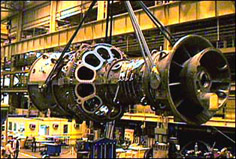Issued on: February 18, 2000
World's Most Advanced Gas Turbine Ready to Cross Commercial Threshold
Energy Secretary Richardson Cites Success of Government-Industry R&D Partnership
Greenville, SC - For natural gas turbines - the technology likely to dominate the growing market for new electric power generation - the future was unveiled today in Greenville, South Carolina.
 |

|
 |
The 330-ton Model MS7001H advanced gas turbine is the size of a locomotive. |
Secretary of Energy Bill Richardson and U.S. Senator Ernest Hollings joined General Electric today in announcing that the company's newest H System™ gas turbine, the most advanced combustion turbine in the world, is ready to cross the commercial threshold.
"Today, we are seeing the most advanced combustion turbine anywhere, incorporating breakthroughs that were barely imagined a decade ago," said Secretary Richardson. "This milestone will not only help maintain a cleaner environment, it will help fuel our growing economy, and it will keep electric bills low in homes and businesses across our country."
The new machine, the size of a large locomotive, is the product of a jointly funded development effort between GE Power Systems and the U.S. Department of Energy. Developed at GE's Greenville manufacturing facility, the turbine passed a critical verification test earlier this month and is being readied for shipment to a power plant being built near Scriba, New York, by Sithe Energies, one of the world's largest independent power producers.
Natural gas turbines are expected to make up more than 80 percent of the power generating capacity to be added in the United States over the next 10 to 15 years. Of the more than 200 new power plant projects announced recently in the United States, 96 percent plan to use natural gas and most will employ gas turbines. Globally, the turbine market also promises to be huge with worldwide power generation perhaps approaching $100 billion over the next decade.
"Gas turbines will be the clear choice for the next wave of power plant construction. The new technology developed and manufactured here in Greenville will be at the crest of that wave," said Senator Hollings. "By keeping the 'Made-in-America' stamp on the world's most sophisticated power turbine, we will keep jobs in America and in South Carolina."
Richardson's and Hollings' remarks came at a ceremony in which GE introduced the gas turbine, officially designated the MS7001H, to nearly 100 prospective customers and other invited guests.
The turbine is the culminating achievement of a Department of Energy research and development effort that began in the early 1990s when GE was one of six developers selected to begin designing concepts for a breakthrough turbine system. The development effort received a major boost in 1993 when it was included in President Clinton's Economic Stimulus Program.
When the program concludes, the Energy Department will have invested almost $100 million in the development effort with GE contributing more than $500 million, including $200 million in the federal program.
Designed to work in a "combined cycle" power plant - a plant that combines gas turbines and steam turbines to produce electricity - the H System™ will be the most efficient power generation system in the world. It will be the first gas turbine to top the 60 percent efficiency threshold -- the "four minute mile" of turbine technology. When the Energy Department began its advanced turbine development program in the early 1990s, the best turbines available had efficiencies of about 50 percent.
Because fuel represents the largest single cost of running a power plant, an increase of 10 percentage points in efficiency can reduce operating costs by as much as $200 million over the life of a typical gas-fired 400-500 megawatt combined cycle plant.
The efficiency gains have been achieved because the turbine fires natural gas nearly 300 degrees hotter than conventional turbines, reaching temperatures of 2600 degrees F. Advanced cooling techniques and new alloys were developed to handle the hotter temperatures. The turbine also employs the world's largest single crystal airfoils, making the turbine blades much more resistant to high temperature cracking than the multi-directional crystal design currently used.
The turbine also operates cleaner than any of today's utility gas turbines. Its nitrogen oxide emission levels of 9 parts-per-million will be half the average of the turbines now in use, making the new technology suitable for siting in the nation's most environmentally constrained areas.
In addition, the H System™ turbine will produce the fewest tons of carbon dioxide per kilowatt of electricity of any gas turbine available today. When deployed commercially, it can make a significant contribution toward reducing greenhouse gases that can cause global warming.
The system introduction today will produce electricity at 60-hertz, making it suitable for the U.S. power grid. GE has also developed a companion H System™ turbine -- the 50-hertz 9H series -- for the overseas market. The 50-hertz version is scheduled to begin commercial service at the Baglan Energy Park in South Wales in 2002.
-End of TechLine-
For more information, contact:
Robert C. Porter, DOE Office of Fossil Energy, 202-586-6503, e-mail: robert.porter@hq.doe.gov
Technical Program Contacts:
Abbie W. Layne, Advanced Turbine Systems Product Manager, National Energy Technology Laboratory, 304-285-4603, e-mail: alayne@netl.doe.gov
Kanwal Mahajan, Project Manager, National Energy Technology Laboratory, 304-285-4965, e-mail: kmahaj@netl.doe.gov
|